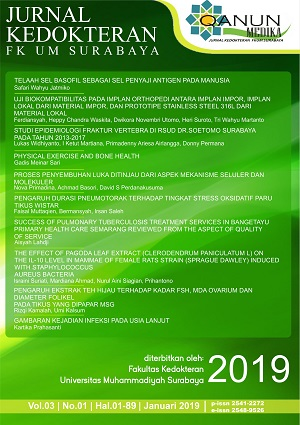Proses Penyembuhan Luka Ditinjau dari Aspek Mekanisme Seluler dan Molekuler
Abstract
ABSTRACT
Wound is the discontinue of the anatomical structure of the body tissue, the healing phase consists of 3 stages, they are the inflammatory phase, which is divided into early inflammation, and late inflammation that occurs from day 0 to day 5 after injury. The Proliferation phase, which includes three main processes, namely: Neoangiogenesis, fibroblast formation and re-epithelialization, occurs from day 3 to day 21 after injury. Maturation phase occurs from day 21 to 1 year after injury which aims to maximize the strength and structural integrity of new tissue fillings, epithelial growth and scar tissue formation. These three phases influence each other and many cells and cytokines play a role in each phase. The amount of research on the wound healing process to achieve satisfactory results with a shorter time than the nominal phase results in a theory of the process of wound healing that is increasingly detailed which will be explained from the aspects of cellular and molecular mechanisms.
Keywords : wound healing, wound healing process, wound healing mechanism, cellular mechanism of wound healing, molecular mechanism of wound healing
Correspondence to : novaprimadina@fk.um-surabaya.ac.id
Â
ABSTRAK
Luka adalah terputusnya kontinuitas struktur anatomi jaringan tubuh, dimana fase penyembuhannya terdiri dari 3 tahap yaitu Fase Inflamasi yang dibagi menjadi early inflammation (Fase haemostasis), dan late inflammation yang terjadi sejak hari ke 0 sampai hari ke 5 pasca terluka. Fase Proliferasi, yang meliputi tiga proses utama yakni: Neoangiogenesis, pembentukan fibroblast dan re-epitelisasi, terjadi dari hari ke-3 sampai hari ke-21 pasca terluka. Fase Maturasi terjadi mulai hari ke-21 sampai 1 tahun pasca luka.yang bertujuan untuk memaksimalkan kekuatan dan integritas struktural jaringan baru pengisi luka, pertumbuhan epitel dan pembentukan jaringan parut. Ketiga fase ini saling mempengaruhi satu sama lain dan banyak sel dan sitokin yang berperan didalam setiap fase. Banyaknya penelitian tentang proses penyembuhan luka untuk mencapai hasil yang memuaskan dengan waktu yang lebih singkat dari fase nomal menghasilkan teori proses penyembuhan luka yang semakin detail yang akan dijelaskan dari aspek mekanisme seluler dan molekuler.
Kata kunci  :penyembuhan luka, proses penyembuhan luka, mekanisme penyembuhan luka, mekanisme seluler penyembuhan luka, mekanisme molekuler penyembuhan luka
Korespondensi : novaprimadina@fk.um-surabaya.ac.id
Full text article
References
DEPKESRI. (2011). Profil Kesehatan Indonesia. Jakarta: Departemen Kesehatan RI.
Dinh T, Braunagel S, Rosenblum BI., (2015), Growth factors in wound healing: the present and the future? Clin Pediatr Med Surg. Vol.32(1), p.109-19.
Driscoll, P. (2014). wound prevalence and wound management : 2012-2020. Opgeroepen op 05 27, 2017, van mediligence.com: http://blog.mediligence.com/2013/01/29/wound-prevalence-and-wound-management-2012-2020/
Faten Khorshid, S. S. (2010). Plectranthus tenuiflorus (Shara) Promotes Wound Healing: In vitro and in vivo Studies. Int. J. of Botany, 69-80
Frisca, Sardjono, C.T., dan Sandra F., 2009, Angiogenesis: Patofisiologi dan Aplikasi Klinis, JKM, Vol 8 (2): 174-87.
Gutner, GC,. (2007). Wound Healing, Normal and Abnormal. In Grabb and Smith’s Plastic Surgery 6th edition (pp. 15-22). Philadelphia: Elseviers.
Haq, FF. (2016). Pengaruh Luka Insisi Terhadap Perbandingan Kadar Tnfα Pada Tikus Putih (Rattus Norvegicus) Galur Wistar, Semarang: Fakultas Kedokteran Universitas Sultan Agung Semarang. Available at : http://repository.unissula.ac.id/5208/1/cover_1.pdf.
Hariani, L. (2017). Pola Proses Penyembuhan Luka sekitar melalui analisis ekspresi EGF, VEGF, TGF-beta, kolagen, MMP-1 dan pembuluha kapiler yang diinduksi adiposed derived mesenchymal stem cells pada luka primer. Surabaya: Ilmu Kedokteran Jenjang Doktor Universitas Airlangga.
Kalangi, S.J.R., 2011, Peran Integrin pada Angiogenesis Penyembuhan Luka, Cermin Dunia Kedokteran, 38(3): 177-181.
Landén, N. X., Li, D., & Ståhle, M. (2016). Transition from inflammation to proliferation: a critical step during wound healing. Cellular and Molecular Life Sci., 73(20), p.3861–3885. https://doi.org/10.1007/s00018-016-2268-0
Prasetyono, T., (2009). General concept of wound healing, revisited, Med. J. Indones vol.18. p.208-16.
Sri Fajriani A, Marsaoly. (2016). Infeksi Luka Post Operasi Pada Pasien Post Operasi Di Bangsal Bedah Rs Pku Muhammadiyah Bantul, available at :http://repository.umy.ac.id/handle/123456789/2838
T Velnar, T Bailey, V Smrkolj, (2009), The Wound Healing Process : an Overview of Cellular and Molecular Mechanism, The J of International Medical Research, p.1528-42.
Werner S, G. R. (2003). Regulation of wound healing by growth factor and cytokines. Physiol Rev 83, 835-870.
Authors

Qanun Medika by FK UM Surabaya is liscence under Lisensi Creative Commons Atribusi 4.0 Internasional.

